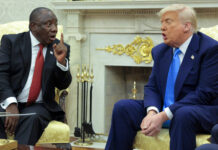
[miningmx.com] — SOUTH Africa’s mining sector could add more than an additional R50bn ($6bn) to the country’s gross domestic product by 2015 if infrastructure bottlenecks were cleared and its share in a growing market for commodities was maintained.
This would be from increased contributions by thermal coal, iron ore and platinum group metals producers; and exclude other major mining sectors like the gold and diamonds.
Speaking on how well South Africa was positioned to make the most of the ongoing commodities price boom, Sanlam Investment Management (SIM) resource specialist Barend Ritter said high commodity prices presented the country a window of opportunity to regain some lost ground.
Since 2001 the resource sector’s growth has underperformed the economy’s growth by one percentage point, in contrast to other resource rich countries like China (+19%), Chile (12%), Russia (10%), Peru (6%) and even Venezuela under the presidency of Hugo Chavez (4%).
Even more worrying, Ritter said, was that South Africa was not well positioned for the future in terms of exploration and projects in the pipeline. “It’s not a great picture. In terms of exploration spend, SA’s share of global spend has fallen from 6% to 3% since 2003; which doesn’t position it well for the future.’
This is reflected in the fact that SA has slipped down to position 67 out of 79 countries in the 2011 Fraser Institute Global Survey of prospecting potential.
“SA has got to take action,’ he said, and identified several key factors that need to be resolved, including providing security of tenure, improving infrastructure and addressing the upward pressure on real wages.
Pointing to Transnet Freight Rail’s inability over the past few years to consistently move more than 70 million tonnes of coal to the Richards Bay Coal Terminal, when the coal terminal had upgraded its capacity to in excess of 90 million tonnes, Ritter said the government should’ve been better prepared for logistical requirements when several smaller suppliers were allowed into the sector.
“We allowed many smaller players and didn’t prepare for the logistics; which meant that efficiencies were compromised,’ he said. “Can we as a society not predict these situations better to prevent this type of thing from happening?’
He said the additional contribution which the export of thermal coal could made to GDP, should the country lift exports from current levels to RBCT’s full capacity by 2015, would amount to $2.1bn. Similarly, the expansion of phase 3 of the Sishen-Saldanha rail line would enable volume growth of 19%, representing another $2.3bn contribution to GDP.
Also, South Africa maintaining its market share in a growing demand environment for platinum group metals by 2015 would add a further $2.3bn.
SIM economist Arthur Kamp pointed out South Africa was not only slipping down the resource rankings. The broader economy was losing ground within the emerging market environment as well.
The latest World Economic Forum Global Competitiveness Index rankings showed the country at 54 and slipping.
He said that while the benefits from mining were supportive of the broader economy, they would not drive potential growth in the long run and that long-term commodities prices were expected to be well below their current level.
“While the terms of trade bonanza has boosted final demand growth and helped the economy recover from the sub-prime crisis, it has also left South Africa vulnerable to any downturn in the global economy and commodity prices,’ Kamp said.
“South Africa is also lagging in the productivity stakes and thus the success of the overall economy going forward is largely reliant on SA remaining an attractive investment destination.’










